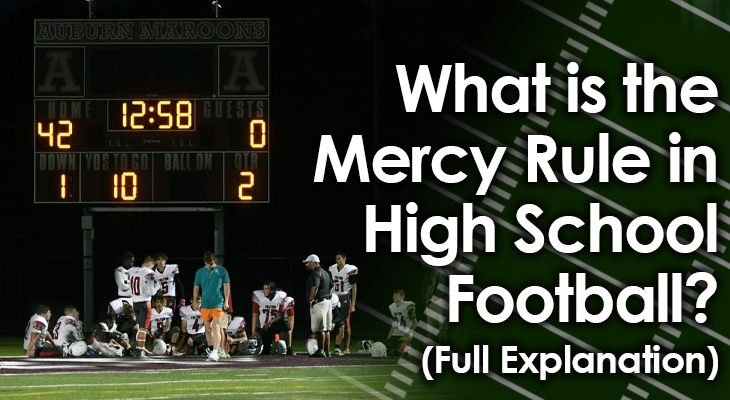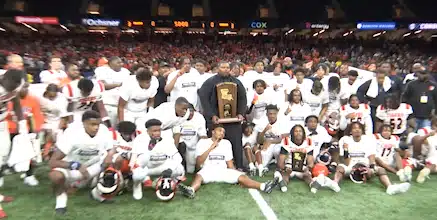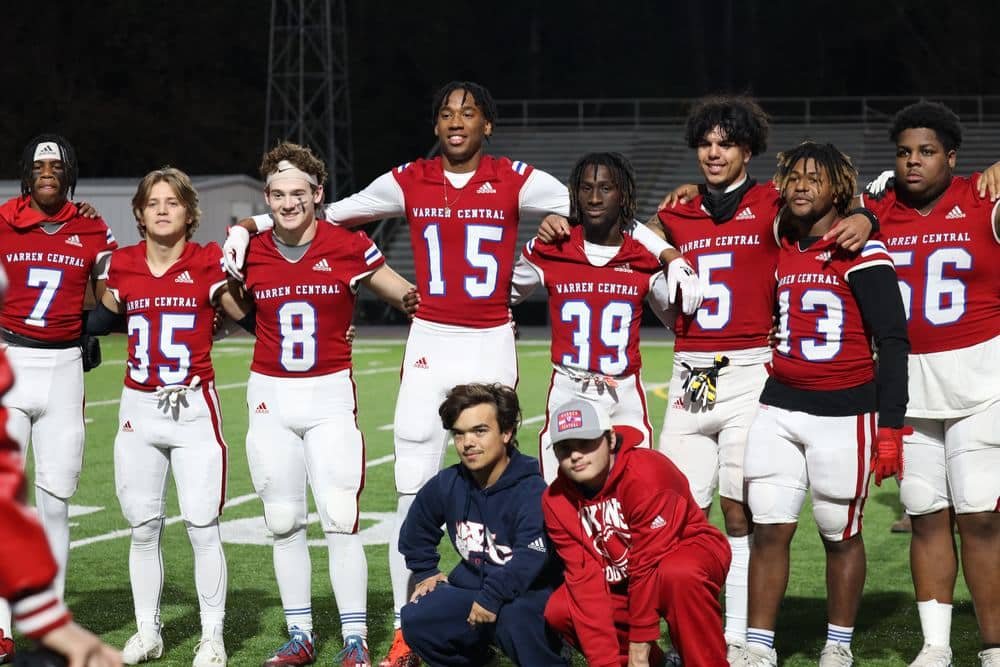Yes, high school football does have a mercy rule. It aims to ensure fair play and safety.
High school sports can get intense. Games sometimes end with a significant points difference. This can be disheartening for the losing team. That’s where the mercy rule comes in. It helps to keep the game enjoyable for everyone. The rule often involves a running clock when one team leads by a large margin.
This shortens the game and reduces the chance of injury. Understanding the mercy rule is crucial for players, coaches, and fans. It ensures the spirit of competition remains positive. Curious about how it works? Let’s dive deeper into the details of the mercy rule in high school football.
Introduction To Mercy Rule
The concept of a mercy rule is often discussed in the world of high school sports. This rule aims to prevent excessive scoring and imbalance between teams. It ensures that games remain fair and respectful for all players involved. But what exactly is the mercy rule, and how did it come about? Let’s dive into its definition and origin in sports.
Definition And Purpose
The mercy rule is designed to end a game early when one team has a significant lead. This rule helps avoid unnecessary humiliation for the losing team. It also protects players from potential injuries due to a prolonged, uneven game. By implementing the mercy rule, schools can maintain sportsmanship and respect among teams.
The rule typically activates when a team leads by a certain number of points. For example, if a football team is leading by 35 points in the second half, the game may end early. This ensures that the game remains enjoyable for all participants, not just the winning team.
Origins In Sports
The origins of the mercy rule can be traced back to various sports. It was first used in youth baseball and softball. Coaches and organizers wanted to prevent lopsided games and keep the spirit of competition alive. Over time, the rule spread to other sports, including high school football.
In high school football, the mercy rule helps keep games competitive and fair. Coaches, players, and fans appreciate the balance it brings to the sport. As a result, it has become a standard practice in many high school leagues across the country.
| Sport | Typical Mercy Rule Threshold |
|---|---|
| Football | 35 points in the second half |
| Baseball | 10 runs after 5 innings |
| Softball | 10 runs after 5 innings |
Understanding the purpose and origins of the mercy rule helps appreciate its importance. It fosters a respectful and safe environment in high school sports.

Credit: www.courierpress.com
Mercy Rule In High School Football
The mercy rule in high school football aims to ensure fair play. This rule helps prevent one team from severely overwhelming another. It keeps the game enjoyable and safe for all players. Many states in the U.S. have adopted this rule. Coaches, players, and fans appreciate its impact on the sport.
Implementation
The mercy rule’s implementation varies by state. Generally, it activates when one team leads by a certain number of points. For example, a lead of 35 points might trigger a running clock. The clock keeps moving, except for timeouts and injuries. This shortens the game and reduces the chance of further score gaps.
Some states use a continuous clock once the mercy rule is activated. This means the clock does not stop for incomplete passes or out-of-bounds plays. The game ends sooner, reducing the potential for injuries or unsportsmanlike behavior.
Common Scenarios
Several scenarios can activate the mercy rule in high school football. One common scenario is a strong team playing against a weaker one. The stronger team quickly builds a large lead. The officials then invoke the mercy rule to prevent further disparity.
Another scenario involves mismatched skill levels. Sometimes, one team has more experienced players. They dominate the game, leading to a significant score difference. The mercy rule steps in to balance the competition.
Weather conditions can also play a role. In bad weather, a large lead might prompt the mercy rule. This helps ensure player safety and game fairness.
Benefits Of The Mercy Rule
The mercy rule in high school football offers many benefits. It focuses on keeping the game safe and fair for all players. This rule ensures that a losing team does not face excessive defeat. It helps maintain the spirit of the game.
Player Safety
Player safety is a top priority in high school football. The mercy rule reduces the risk of injuries. When one team leads by a large margin, the game clock runs continuously. This shortens the game and lessens physical strain on players. Less time on the field means fewer chances for accidents or injuries.
Coaches can substitute less experienced players. This prevents overexertion of key players. It also gives everyone a chance to play without the pressure of winning. The mercy rule keeps the game safe and enjoyable for all.
Sportsmanship
Sportsmanship is vital in high school sports. The mercy rule promotes respect and fairness. It stops one team from running up the score. This prevents humiliation for the losing team. Players learn to respect their opponents, no matter the score.
It also teaches humility to the winning team. They learn to win gracefully without showing off. The mercy rule ensures that both teams finish the game with dignity. It creates a positive and respectful environment on the field.

Credit: www.highschoolot.com
Criticisms Of The Mercy Rule
The mercy rule in high school football has its critics. Many argue it impacts the competitive spirit and overall game experience. Let’s explore these criticisms in more detail.
Competitive Spirit Concerns
The mercy rule can be seen as a blow to the competitive spirit. It may discourage teams from giving their best effort when they know the game can end early. Players may not push their limits, knowing the outcome is already decided.
Some coaches believe that every play, every moment, is a chance to learn and improve. Cutting the game short denies athletes these opportunities. The focus shifts from skill development to simply running out the clock.
Impact On Game Experience
The mercy rule can also affect the overall game experience for players, coaches, and fans. A shortened game may leave fans feeling disappointed. They come to see a full game, not a partial one.
For players, the experience is equally important. Young athletes look forward to showcasing their skills and enjoying the game. Ending the game early can leave them feeling unfulfilled.
Coaches may find it hard to manage player expectations. They must balance the desire to compete with the need to protect their players from demoralizing losses. This can be a tough position to be in.
In summary, while the mercy rule aims to prevent blowouts, it brings its own set of challenges. Critics argue it undermines the competitive spirit and impacts the overall experience. Understanding these criticisms is key to evaluating the effectiveness of the mercy rule in high school football.
Comparison With Other Sports
High school football has its own unique set of rules and regulations. One rule often discussed is the mercy rule. This rule ensures that games do not become too one-sided. But how does this rule compare with other sports? Let’s take a look.
Baseball And Softball
In baseball and softball, a mercy rule also exists. It is called the “run rule.” If a team leads by a certain number of runs after a specific inning, the game ends early. For instance, if a team leads by 10 runs after five innings, the game can be called. This rule helps prevent blowout games.
Basketball And Soccer
Basketball and soccer have different ways of handling one-sided games. In basketball, a running clock may be used. This means the clock does not stop for fouls or timeouts. This speeds up the game and reduces the final score’s margin. In soccer, the referee may shorten the halves. This is less common but can happen to avoid humiliation.
State-specific Rules
High school football in the United States follows different rules in each state. This includes the implementation of the mercy rule. The mercy rule is designed to prevent one team from overwhelming another. It ensures a fair and respectful game. Each state has its own version of this rule. Let’s explore the variations across states and look at some notable examples.
Variations Across States
Each state has its own guidelines for the mercy rule in high school football. These rules determine when the mercy rule is applied and how it affects the game. Some states have strict guidelines, while others are more flexible. Here are a few variations:
- Running Clock: In some states, a running clock starts when a team leads by a certain number of points. This means the clock does not stop for incomplete passes, out-of-bounds plays, or other situations where it usually would.
- Game Termination: Other states may end the game early if the point differential reaches a specific threshold. This is to avoid unnecessary injury and maintain sportsmanship.
- Coach and Referee Discretion: In some areas, the decision to implement the mercy rule can be left to the discretion of the coaches and referees. They will decide if the game should continue or end based on the competitiveness and safety of the players.
Notable Examples
Here are some notable examples of state-specific mercy rules in high school football:
| State | Rule |
|---|---|
| California | A running clock starts when a team leads by 35 points or more. |
| Texas | The game ends if a team leads by 45 points at halftime or later. |
| Florida | Coaches can agree to a running clock if the point difference is 35 or more. |
Understanding these rules helps players and coaches prepare for different situations. It ensures the game remains fair and enjoyable for everyone involved.
Coaches And Players Perspectives
High school football often sparks intense debates. One such topic is the mercy rule. Coaches and players have unique perspectives on this rule. Their insights offer a deeper understanding of its impact on the game.
Coaches Opinions
Many coaches see the mercy rule as a necessity. It helps protect players from injury. It also prevents demoralizing blowouts. Some coaches believe it ensures sportsmanship. They argue it keeps the focus on skill development. Winning by a large margin doesn’t benefit either team. The mercy rule can maintain a positive atmosphere. Coaches emphasize its role in keeping games fair.
Players Experiences
Players have mixed feelings about the mercy rule. Some feel it protects their well-being. It stops games from becoming dangerous. Others think it limits their playing time. They want to compete for the full duration. The rule can feel like an early end to their efforts. Young athletes value the chance to learn from every minute on the field. They believe every play provides growth opportunities. The mercy rule can be both a relief and a frustration.
Future Of The Mercy Rule
The future of the mercy rule in high school football is a topic of great interest. With evolving attitudes and the potential for changes, many wonder what lies ahead. Let’s explore these aspects to understand the possible direction.
Potential Changes
The mercy rule’s future may involve modifications. These changes could make the rule more effective. For example, some suggest lowering the point threshold. This would activate the mercy rule sooner. It might help prevent overwhelming mismatches. Others propose more flexible guidelines. This would allow referees to use discretion based on the game’s context. Such changes could address current concerns better.
Evolving Attitudes
Attitudes towards the mercy rule are evolving. Many believe it promotes sportsmanship. It prevents unnecessary humiliation for losing teams. Coaches and parents support its intent. Some players also see its value. They understand the need to protect young athletes. But there are those who feel it affects competitive spirit. They argue that overcoming challenges is part of sports. These differing views shape discussions about the rule’s future. As opinions evolve, so might the rule itself.

Credit: patch.com
Frequently Asked Questions
What Is The Mercy Rule In High School Football?
The mercy rule aims to prevent lopsided scores in high school football. It typically involves a running clock when one team gains a significant lead.
When Is The Mercy Rule Applied?
The mercy rule is applied when a team leads by a specific number of points. This threshold varies by state.
How Does The Mercy Rule Work?
When the mercy rule is in effect, the game clock runs continuously. This reduces the game’s overall length.
Does Every State Have A Mercy Rule?
Not every state has adopted the mercy rule for high school football. Policies can differ significantly between states.
Conclusion
High school football can be intense. Mercy rules help keep games fair. They ensure safety and sportsmanship. Such rules prevent blowouts and injuries. Coaches, players, and parents appreciate them. They maintain the spirit of competition. Understanding these rules is important.
It benefits everyone involved. High school football remains enjoyable. Balanced and respectful games create a positive experience.




